Unveiling the Historical Significance, Architectural Marvels, and Artistic & Cultural Delights of East Timor’s Capital

Introduction:
Welcome to Dili, the captivating capital city of East Timor. In this article, we will take a closer look at the historical significance, architectural marvels, and artistic and cultural delights that make Dili a truly unique destination. Join us on a journey to discover the rich heritage and vibrant cultural scene of this enchanting city.
Historical Significance:
Dili is a city steeped in historical significance, playing a pivotal role in the nation’s journey towards independence. During the Indonesian occupation, Dili became a symbol of resistance and resilience for the Timorese people. The city witnessed numerous demonstrations and acts of defiance, including the infamous Santa Cruz massacre in 1991. Today, Dili stands as a testament to the courage and determination of the East Timorese, with historical landmarks and memorials scattered throughout the city. The Santa Cruz Cemetery serves as a poignant reminder of the sacrifices made by those fighting for freedom. The Resistance Museum showcases artifacts and exhibits that chronicle the nation’s struggle, offering visitors a deeper understanding of East Timor’s history. Exploring Dili’s historical significance is an essential part of understanding the spirit and resilience of its people.
Architecture & Natural Splendors:
Dili’s architecture is a captivating blend of traditional Timorese influences and Portuguese colonial heritage. The cityscape is adorned with colorful buildings, intricate balconies, and charming colonial structures. The Motael Church, an iconic landmark, showcases the architectural grandeur of Dili with its striking façade and ornate interior. As you wander through the city, you’ll encounter a myriad of architectural gems that tell the story of Dili’s past and present. Beyond its architectural wonders, Dili is blessed with natural splendors that will leave you in awe. Pristine beaches line the coast, offering a tranquil escape and opportunities for water activities. The lush mountains that surround the city provide breathtaking panoramic views and opportunities for hiking and exploration. Dili’s architectural marvels and natural beauty combine to create a truly picturesque setting.
Art & Cultural Delights:
Dili’s vibrant art scene and rich cultural heritage are a testament to the city’s creative spirit. The city is home to numerous art galleries and cultural centers that showcase the works of local artists and artisans. Traditional Timorese crafts, such as intricate textiles, pottery, and woodcarvings, can be found in the bustling markets and art shops. The Tais Market, a vibrant hub of activity, offers a glimpse into the traditional crafts and lively atmosphere of Dili. Music and dance are integral parts of Timorese culture, and Dili hosts regular performances that showcase the diversity and beauty of these art forms. The annual Dili International Film Festival brings together local and international filmmakers, providing a platform to share stories and celebrate the power of cinema. Dili’s art and cultural delights are a testament to the city’s vibrant spirit and the pride its people take in their cultural heritage.
Conclusion:
Dili, with its historical significance, architectural marvels, and artistic and cultural treasures, is a city that invites exploration and appreciation. From its historical landmarks to its diverse architecture, Dili showcases the rich heritage of East Timor. The city’s natural splendors and artistic expressions add to its allure, offering visitors a truly immersive experience. As you wander through the streets of Dili, you will be captivated by its historical significance, enchanted by its architectural beauty, and inspired by its vibrant art and cultural scene. Dili is a city that embraces its past while embracing the future, inviting visitors to discover the unique wonders that make it a truly special destination in East Timor.
©2024 | Authored by DocThomas.Art

